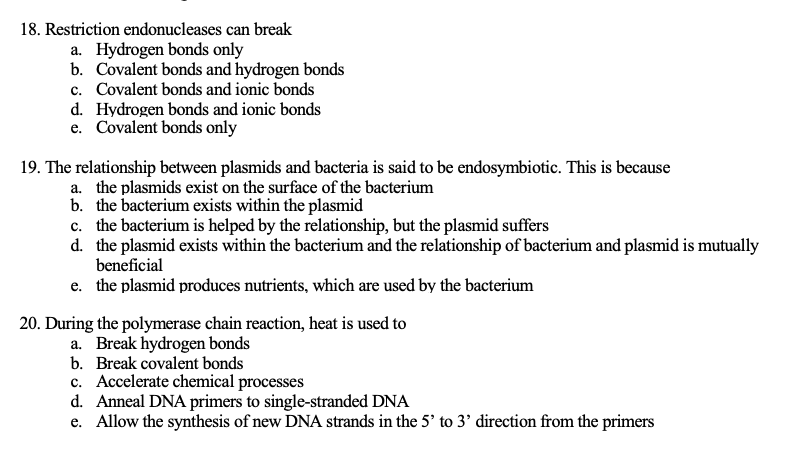18. Restriction endonucleases can break a. Hydrogen bonds only b. Covalent bonds and hydrogen bonds c. Covalent bonds and ionic bonds d. Hydrogen bonds and ionic bonds e. Covalent bonds only
18. Restriction endonucleases can break a. Hydrogen bonds only b. Covalent bonds and hydrogen bonds c. Covalent bonds and ionic bonds d. Hydrogen bonds and ionic bonds e. Covalent bonds only
Biology: The Dynamic Science (MindTap Course List)
4th Edition
ISBN:9781305389892
Author:Peter J. Russell, Paul E. Hertz, Beverly McMillan
Publisher:Peter J. Russell, Paul E. Hertz, Beverly McMillan
Chapter17: Bacterial And Viral Genetics
Section: Chapter Questions
Problem 4TYK
Related questions
Question

Transcribed Image Text:18. Restriction endonucleases can break
a. Hydrogen bonds only
b. Covalent bonds and hydrogen bonds
c. Covalent bonds and ionic bonds
d. Hydrogen bonds and ionic bonds
e. Covalent bonds only
19. The relationship between plasmids and bacteria is said to be endosymbiotic. This is because
a. the plasmids exist on the surface of the bacterium
b. the bacterium exists within the plasmid
c. the bacterium is helped by the relationship, but the plasmid suffers
d. the plasmid exists within the bacterium and the relationship of bacterium and plasmid is mutually
beneficial
e. the plasmid produces nutrients, which are used by the bacterium
20. During the polymerase chain reaction, heat is used to
a. Break hydrogen bonds
b. Break covalent bonds
c. Accelerate chemical processes
d. Anneal DNA primers to single-stranded DNA
e. Allow the synthesis of new DNA strands in the 5' to 3' direction from the primers
Expert Solution
This question has been solved!
Explore an expertly crafted, step-by-step solution for a thorough understanding of key concepts.
Step by step
Solved in 2 steps

Knowledge Booster
Learn more about
Need a deep-dive on the concept behind this application? Look no further. Learn more about this topic, biology and related others by exploring similar questions and additional content below.Recommended textbooks for you

Biology: The Dynamic Science (MindTap Course List)
Biology
ISBN:
9781305389892
Author:
Peter J. Russell, Paul E. Hertz, Beverly McMillan
Publisher:
Cengage Learning

Biology: The Unity and Diversity of Life (MindTap…
Biology
ISBN:
9781305073951
Author:
Cecie Starr, Ralph Taggart, Christine Evers, Lisa Starr
Publisher:
Cengage Learning

Biology: The Unity and Diversity of Life (MindTap…
Biology
ISBN:
9781337408332
Author:
Cecie Starr, Ralph Taggart, Christine Evers, Lisa Starr
Publisher:
Cengage Learning

Biology: The Dynamic Science (MindTap Course List)
Biology
ISBN:
9781305389892
Author:
Peter J. Russell, Paul E. Hertz, Beverly McMillan
Publisher:
Cengage Learning

Biology: The Unity and Diversity of Life (MindTap…
Biology
ISBN:
9781305073951
Author:
Cecie Starr, Ralph Taggart, Christine Evers, Lisa Starr
Publisher:
Cengage Learning

Biology: The Unity and Diversity of Life (MindTap…
Biology
ISBN:
9781337408332
Author:
Cecie Starr, Ralph Taggart, Christine Evers, Lisa Starr
Publisher:
Cengage Learning